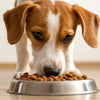Why Does Kibble Give My Dog Diarrhea? Understanding the Causes and Solutions
- Houndsy
Table of Contents
- Introduction
- Understanding Diarrhea in Dogs
- Why Does Kibble Give My Dog Diarrhea?
- Transitioning to a New Kibble
- Maintaining Digestive Health
- Conclusion
Introduction
As loving pet owners, we want nothing but the best for our furry companions. However, one common concern many of us face is gastrointestinal upset, particularly diarrhea. Did you know that nearly 1 in 4 dogs suffers from diarrhea at some point in their lives? This statistic is alarming and raises several questions. One of the most pressing is: Why does kibble give my dog diarrhea?
In this blog post, we aim to explore the various reasons behind this uncomfortable condition, particularly focusing on kibble—the staple diet for many dogs. We'll examine the common ingredients in dog food that might cause digestive issues, how dietary changes can affect your dog's stomach, and what steps we can take to alleviate or prevent these problems. By the end of this article, we hope to provide you with a comprehensive understanding of the relationship between kibble and diarrhea, empowering you to make informed decisions regarding your pet's diet.
So, let’s dive into the world of dog nutrition and digestive health, and reflect on our routines and choices as dog parents. Understanding our pets' dietary needs is crucial, and we believe that every dog deserves to eat well without the discomfort of an upset stomach.
Understanding Diarrhea in Dogs
What is Diarrhea?
Diarrhea is defined as loose or watery stools that occur more frequently than normal. For dogs, this can manifest in various ways, including urgency to go outside, straining, or even accidents in the house. While occasional diarrhea is not uncommon, persistent bouts can lead to dehydration and can indicate underlying health issues.
Types of Diarrhea
Diarrhea can generally be categorized into three types:
- Acute Diarrhea: This is sudden and usually lasts less than a few days. It can be caused by dietary indiscretion, infections, or sudden changes in diet.
- Chronic Diarrhea: This lasts longer, often more than two weeks, and may require veterinary evaluation to determine underlying causes.
- Dietary-Induced Diarrhea: This type is directly linked to food intake, such as kibble, and may be due to ingredients that upset the digestive system.
Recognizing the Symptoms
It’s essential to recognize the signs of diarrhea in your dog. Common symptoms include:
- Frequent, watery bowel movements
- Straining to defecate
- Lethargy or decreased activity
- Loss of appetite
- Vomiting
- Dehydration (check for dry gums or skin elasticity)
If your dog exhibits severe or prolonged symptoms, it is crucial to consult a veterinarian.
Why Does Kibble Give My Dog Diarrhea?
Common Causes of Kibble-Induced Diarrhea
- Food Sensitivities and Allergies Many dogs can develop sensitivities or allergies to certain ingredients commonly found in kibble, such as grains, specific proteins (like chicken or beef), or artificial additives. When a dog consumes a food they are allergic to, it can trigger an immune response, resulting in gastrointestinal upset.
- Low-Quality Ingredients Not all kibble is created equal. Many commercial dog foods are made with low-quality ingredients, including fillers and artificial additives, which can be hard for dogs to digest. Ingredients like corn, soy, and by-products can lead to stomach irritation and diarrhea.
- Sudden Dietary Changes Dogs have sensitive digestive systems, and abruptly changing their diet can lead to diarrhea. When transitioning to a new kibble, it’s essential to do so gradually to allow your dog's digestive system to adjust.
- Overfeeding Feeding your dog too much kibble can overwhelm their digestive system, leading to loose stools. It's important to follow the feeding guidelines based on your dog's weight, age, and activity level.
- Bacterial Contamination Sometimes, kibble can be contaminated with harmful bacteria, which can cause gastrointestinal distress. Always ensure you purchase food from reputable brands and check for recalls.
- Lack of Digestive Enzymes Dogs require specific enzymes to break down their food effectively. A sudden change in diet can disrupt the production of these enzymes, leading to digestive upset.
Identifying Problem Ingredients
To determine whether kibble is causing your dog’s diarrhea, pay attention to the ingredient list. Here are some common offenders:
- Grains: Wheat, corn, and soy are known allergens for many dogs.
- Artificial Additives: Preservatives, colors, and flavors can irritate sensitive digestive systems.
- Low-Quality Proteins: Look for whole meats rather than by-products or meals.
- Excessive Fillers: Foods high in fillers provide little nutritional value and can upset digestion.
Transitioning to a New Kibble
Gradual Dietary Changes
When changing your dog’s food, we recommend a gradual transition over seven to ten days. Here’s a simple plan:
- Days 1-3: Mix 25% of the new kibble with 75% of the old kibble.
- Days 4-6: Increase to 50% new kibble and 50% old kibble.
- Days 7-10: Move to 75% new kibble and 25% old kibble.
- Day 11: Feed only the new kibble.
This gradual transition helps your dog's digestive system adapt to the new food, potentially reducing the risk of diarrhea.
Maintaining Digestive Health
Choosing the Right Kibble
Selecting a high-quality kibble can make a significant difference in your dog’s digestive health. Here’s what to look for:
- Limited Ingredients: Foods with fewer ingredients can minimize the risk of allergens.
- High-Quality Proteins: Fresh or freeze-dried meats should be the primary ingredient.
- Digestible Carbohydrates: Sweet potatoes and brown rice are excellent sources of energy without causing irritation.
- Added Probiotics: These can support gut health and improve digestion.
Hydration is Key
Diarrhea can lead to dehydration, so it is essential to ensure your dog has constant access to fresh water. During bouts of diarrhea, you might consider offering an electrolyte solution designed for pets.
Monitoring Your Dog’s Health
Keep an eye on your dog's overall health. If diarrhea persists beyond a few days, or if your dog shows other concerning signs (like vomiting or lethargy), it’s critical to consult with a veterinarian.
Conclusion
Understanding why kibble might give your dog diarrhea is crucial for maintaining their health and well-being. By being aware of food sensitivities, selecting high-quality kibble, and transitioning diets gradually, we can help our pets enjoy their meals without discomfort.
As responsible pet owners, we should always pay attention to our dog's reactions to food and make necessary adjustments. If you're looking for a practical solution to simplify your dog’s feeding routine, consider the Houndsy Kibble Dispenser. Our innovative design not only ensures perfect portions every time but also makes feeding a convenient and enjoyable experience. Explore the Houndsy Kibble Dispenser here.
FAQ
Can changing my dog’s kibble cause diarrhea?
Yes, sudden changes in diet can lead to gastrointestinal upset, including diarrhea. It’s essential to transition gradually.
What are the signs that my dog might have a food allergy?
Common signs include diarrhea, vomiting, itchy skin, and excessive licking. If you suspect a food allergy, consult your veterinarian.
How long does food-related diarrhea last?
Food-related diarrhea usually resolves within a few days, but if it persists longer than that, seek veterinary advice.
Is it safe to withhold food during diarrhea?
It is generally safe to withhold food for 12 to 24 hours to let the gastrointestinal system rest, but ensure your dog has access to fresh water.
What should I do if my dog has severe diarrhea?
If your dog exhibits severe symptoms, such as lethargy, blood in the stool, or persistent diarrhea, consult your veterinarian immediately.
By taking proactive measures and being attentive to our dog’s dietary needs, we can help ensure they lead healthy and happy lives.












